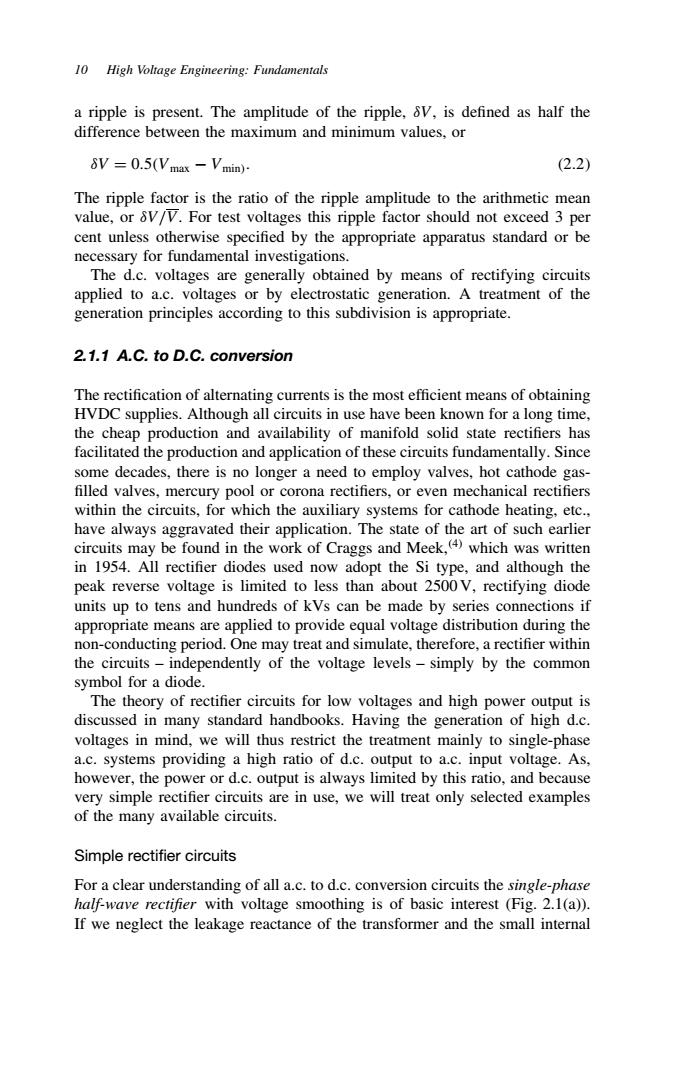正在加载图片...

10 High Voltage Engineering:Fundamentals a ripple is present.The amplitude of the ripple,8V,is defined as half the difference between the maximum and minimum values,or V =0.5(Vmax -Vmin). (2.2) The ripple factor is the ratio of the ripple amplitude to the arithmetic mean value,or 8V/V.For test voltages this ripple factor should not exceed 3 per cent unless otherwise specified by the appropriate apparatus standard or be necessary for fundamental investigations. The d.c.voltages are generally obtained by means of rectifying circuits applied to a.c.voltages or by electrostatic generation.A treatment of the generation principles according to this subdivision is appropriate. 2.1.1 A.C.to D.C.conversion The rectification of alternating currents is the most efficient means of obtaining HVDC supplies.Although all circuits in use have been known for a long time, the cheap production and availability of manifold solid state rectifiers has facilitated the production and application of these circuits fundamentally.Since some decades,there is no longer a need to employ valves,hot cathode gas- filled valves,mercury pool or corona rectifiers,or even mechanical rectifiers within the circuits,for which the auxiliary systems for cathode heating,etc., have always aggravated their application.The state of the art of such earlier circuits may be found in the work of Craggs and Meek,(4)which was written in 1954.All rectifier diodes used now adopt the Si type,and although the peak reverse voltage is limited to less than about 2500V,rectifying diode units up to tens and hundreds of kVs can be made by series connections if appropriate means are applied to provide equal voltage distribution during the non-conducting period.One may treat and simulate,therefore,a rectifier within the circuits-independently of the voltage levels-simply by the common symbol for a diode. The theory of rectifier circuits for low voltages and high power output is discussed in many standard handbooks.Having the generation of high d.c. voltages in mind,we will thus restrict the treatment mainly to single-phase a.c.systems providing a high ratio of d.c.output to a.c.input voltage.As, however,the power or d.c.output is always limited by this ratio,and because very simple rectifier circuits are in use,we will treat only selected examples of the many available circuits. Simple rectifier circuits For a clear understanding of all a.c.to d.c.conversion circuits the single-phase half-wave rectifier with voltage smoothing is of basic interest (Fig.2.1(a)). If we neglect the leakage reactance of the transformer and the small internal10 High Voltage Engineering: Fundamentals a ripple is present. The amplitude of the ripple, υV, is defined as half the difference between the maximum and minimum values, or υV D 0.5Vmax Vmin. 2.2 The ripple factor is the ratio of the ripple amplitude to the arithmetic mean value, or υV/V. For test voltages this ripple factor should not exceed 3 per cent unless otherwise specified by the appropriate apparatus standard or be necessary for fundamental investigations. The d.c. voltages are generally obtained by means of rectifying circuits applied to a.c. voltages or by electrostatic generation. A treatment of the generation principles according to this subdivision is appropriate. 2.1.1 A.C. to D.C. conversion The rectification of alternating currents is the most efficient means of obtaining HVDC supplies. Although all circuits in use have been known for a long time, the cheap production and availability of manifold solid state rectifiers has facilitated the production and application of these circuits fundamentally. Since some decades, there is no longer a need to employ valves, hot cathode gas- filled valves, mercury pool or corona rectifiers, or even mechanical rectifiers within the circuits, for which the auxiliary systems for cathode heating, etc., have always aggravated their application. The state of the art of such earlier circuits may be found in the work of Craggs and Meek,4 which was written in 1954. All rectifier diodes used now adopt the Si type, and although the peak reverse voltage is limited to less than about 2500 V, rectifying diode units up to tens and hundreds of kVs can be made by series connections if appropriate means are applied to provide equal voltage distribution during the non-conducting period. One may treat and simulate, therefore, a rectifier within the circuits – independently of the voltage levels – simply by the common symbol for a diode. The theory of rectifier circuits for low voltages and high power output is discussed in many standard handbooks. Having the generation of high d.c. voltages in mind, we will thus restrict the treatment mainly to single-phase a.c. systems providing a high ratio of d.c. output to a.c. input voltage. As, however, the power or d.c. output is always limited by this ratio, and because very simple rectifier circuits are in use, we will treat only selected examples of the many available circuits. Simple rectifier circuits For a clear understanding of all a.c. to d.c. conversion circuits the single-phase half-wave rectifier with voltage smoothing is of basic interest (Fig. 2.1(a)). If we neglect the leakage reactance of the transformer and the small internal����